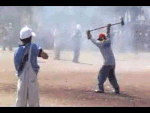4 Essential Core Exercises for Football
Some of the key things we have to think about when we are training our core strength for football is understanding the idea of training the core or the trunk? At Garage Strength, we actually refer to it as the trunk, but we will use the core term because that is the familiar nomenclature for everyone.

So when training core strength for football, we have to think that most athletes are on a field and are rotating quite a bit. The trunk has to be strong in an omnidirectional perspective that includes a lot of dynamic aspects with core strength on the football field. It is still okay to train the core with isolation work, but we also love to train it from a broader, global perspective. We think it is important to do a lot of rotational work and full-body core-specific work and what transfers best over to the football field.
We will use full-body work that triggers core strength as well as more explosive exercises that can be used immediately to improve core strength for football.

1. Isometric Lunge With A Cross Lateral Punch
We doubt most athletes have ever done this movement.
We want to get in a lunge position with the mindset of a lineman kicking back for pass protection or a running back in a full sprint having to hit a stiff arm. We want the back leg planted firmly with the front leg shin to be almost completely vertical. We want the arm gripping the cable crossover machine (we use the XPT Cable Crossover Machine) to be on the same side as the leg behind the torso. The opposite arm is planted upon the chest. We then punch the arm holding the cable grip across the chest. We then perform the eccentric nice and easy, feeling the feet grinding into the ground.

Do this for two to three sets of five to ten reps on each side. Utilize this movement to see which side is stronger and which side is weaker. This movement will enable athletes to improve throwing a stiff arm, decelerate quicker, and help with blocking. The improvement in the ability to deceleration not only improves dynamic trunk control (DTC) but drastically improves the ability to cut.
2. Explosive Med Ball Slams
A lot of people think we have to train the abs in isolation because the abs tend to get more sore. Core training with isolation is phenomenal but if we want to magnify the transfer of training we have to do full bodywork, full explosive work. This is a key concept. When training the core/trunk, we need to train the core/trunk properly so we can hold the trunk/core in specific positions. That’s why we like med ball slams--we want to utilize some very, very explosive core work.

As a quick aside, we like to pre-fatigue the abs with isolation movements before a full-body explosive ab exercise. By pre-fatiguing with isolation work, we will feel the core and trunk even more during the movement. This feeling creates a greater mind-muscle connection, it optimizes power output and trunk control. And that is the goal! It is all about DTC, stability, and power output from the core.
That’s why we love explosive med ball slams. Raise the med ball above the head and come up all the way on the toes. Then slam down, using the whole body through the trunk to drive the medball rapidly into the ground. Make sure to get full extension before bringing the hands down, squeezing the gut into flexion as the ball is barrelled into the floor. Do this for three sets of five to ten reps. We can even add in some rotation as we get better at the movement.
Think about how this movement simulates the exact same feeling of doing a swim move or dumping an athlete who is too low.
3. Roman Chair Kettlebell Drops
This movement is extremely unique and requires specialized equipment, like a back extension or roman chair to perform. Most gyms have some type of back extension or roman chair to perform this movement.
It is important to train the core explosively from a global perspective. The roman chair kettlebell drop uses abduction and adduction. We will start by dropping the kettlebell and explosively bend to grab the falling kettlebell. Now as we fatigue we will eliminate the drop and just perform a traditional rep.

The whole goal is to improve the way the hips coordinate with the transverse abs (the obliques). It will also show us a little bit of force absorption. We are going to squeeze into the back extension or roman chair squeezing through the groin with one leg and pushing up with the other leg. We will look like we are laying on our side. We want to trigger the obliques and follow them up with a little bit of a drop, bend to catch the falling kettlebell, and explosively return to the neutral position. Finish off with some normal reps without the dropping of the kettlebell. Do this for three sets of five to seven reps on each side.
The whole concept is that when doing the drop is to absorb the energy and come up as fast as one can. At the top, we can get a little bit of isometric muscular action. This movement can be done two times a week and do both sides. As improvement with the movement comes with time, try to drop the kettlebell for a little bit longer of a drop to improve the overall force absorption through the core.
4. Hollow Body Kettlebell Stiff Arm
Holding a hollow body, pushing the belly button to the floor with the legs and shoulders raised off the floor, we will alternate pressing the kettlebells off the chest. Ideally, we won’t even have the elbows down, instead, we want to be holding the elbows off the ground. Do this for three sets of five to ten alternating reps.
This movement can be utilized specifically with the explosive med ball throw because the hollow body kettlebell stiff-arm exercise isometrically targets the core/trunk. The isolation muscular action pre-fatigues the muscles to transfer very well into performing the med ball slams.
Recap
Football has a lot of dynamic movements with the trunk. Athletes have to throw stiff-arms, shed blockers, and post up on different athletes. Training the trunk/core appropriately allows the body to create a solid base of a shelf to transfer the power most effectively. The core is like an epicenter. It is the place all muscular power travels to and through to execute strength, explosiveness, and athleticism. It is pivotal that the core is trained in a way that the body’s musculature can most effectively utilize its strength and explosiveness to perform at peak athleticism. These four exercises will help.
DANE MILLER
Dane Miller is the owner and founder of Garage Strength Sports Performance. He works with a select handful of clients on building comprehensive programs for fitness and nutrition. Several times a year he leads a workshop for coaches, trainers, and fitness enthusiasts.


